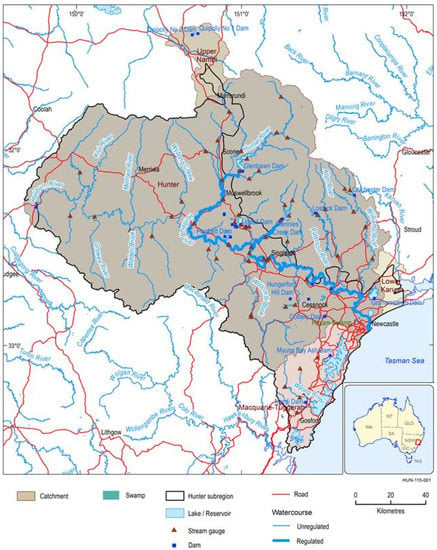You're using an outdated browser. Please upgrade to a modern browser for the best experience.
Please note this is a comparison between Version 1 by Anastasia Mortimer and Version 2 by Conner Chen.
The realization of the 2030 Agenda for Sustainable Development requires local governments globally to integrate Sustainable Development Goals (SDGs) into their policy and practice. In the case of the Hunter Valley Region of Australia, a key sustainable development issue is climate change-induced flooding. The localization and mainstreaming of SDG 13 on climate action can support tangible municipal climate actions in the Region.
- SDG 13
- sustainable development goal
- localization
- disaster risk reduction
- Flood
- Hunter Valley
1. Introduction
The 2030 Agenda for Sustainable Development was initiated by the United Nations in 2015, providing 17 sustainable development goals (SDGs) to address the world’s most pressing social, environmental and economic development issues [1]. For the global realization of the 2030 Agenda to occur, SDG integration into policy and practice by all nation states, across all levels of government is required [2][3][2,3]. “Localization” or the “process of defining; implementing; and monitoring strategies at the local level for achievable global, national and subnational sustainable goals and targets” [4] is essential for each country to reach their commitments to the 2030 Agenda [3]. Municipal governments are arguably best placed for such implementation because “local government is the sphere of government closest to individuals and their communities” [5] and can, therefore, effectively integrate SDGs that best reflect the needs of their communities [6]. In global scholarship, local governments are referred to as municipal governments or municipalities. However, in Australia, the local tier of government is referred to as ‘councils’ or ‘local councils’, and the region they govern is commonly referred to as Local Government Areas (LGAs). Therefore, when references are made in this research to municipal governments and local councils, it is a reference to local administrative tiers of government.
In Australia, a key sustainable development issue is climate change-induced natural hazards. The nation is highly exposed to a variety of hazard types, such as bushfires, cyclones and droughts; however, rainfall-induced floods are Australia’s most widespread climate-related disaster due to their annual occurrence and damage rate [7][8][7,8]. Assessments completed by councils in the Hunter Valley indicate high to extreme risk of flash flood, riverine flood and storms. The Hunter Region (and greater State of New South Wales) experienced large and devastating floods in 2021 and 2022, following consecutive La Niña years. Although La Niña traditionally occurs in a cycle of 3–7 years [9][10][10,11], changing weather systems caused by global warming are contributing to concurrent and large-scale downpours during La Niña years [11][12]. This in turn increases flood risk during periods of heavy rainfall, where these deluges inundate catchments and contribute to subsequent flooding [11][12].
It is predicted that changing weather systems caused by climate change will increase the severity of high-rainfall flood events in Australia [12][13][14][15][16][13,14,15,16,17]. The latest IPCC report highlights that, without global climate action, warming will likely exceed 1.5 °C and 2 °C scenarios this century [16][17]. With floods being the most damaging and costly disasters, there is an imperative for local-level climate action that incorporates strategies for reducing the disaster risk of future floods in Hunter Valley communities.

2. The Hunter Valley, Climate Change Floods and SDGs
The Hunter Valley is a sub-region of the State of New South Wales (NSW), Australia. The region is made up of the local government areas (LGAs) of Cessnock, Dungog, Lake Macquarie, Maitland, Mid-Coast, Muswellbrook, Newcastle, Port Stephens, Singleton and Upper Hunter. The Valley is bounded geologically by the Sydney Basin and the Hunter-Mooki fault, and water catchments are defined by the Liverpool, Hunter and Great Dividing Ranges. Its length is approximately 230 km north-south and 210 km east-west [17][20]. The greater Hunter is situated in NSW’s largest coastal catchment area [18][9], including the Hunter River catchment in the eastern region, Manning and Karuah in the northern region, and Lake Macquarie and Hawkesbury-Nepean rivers, which make up the larger catchments within these LGAs [18][9]. Figure 1 [17][20] highlights the region and intricate catchments made up of river and creek systems throughout the Hunter Valley. Excluding the Newcastle urban area, the Hunter Valley is home to nearly 300,000 people [19][21] and is experiencing rapid population growth [20][22], thus resulting in increased exposure and risk to climate change impacts. The key industries of agriculture and mining [21][23] are vulnerable to climate change impacts, such as increased temperatures, erratic rainfall, drought and floods.
